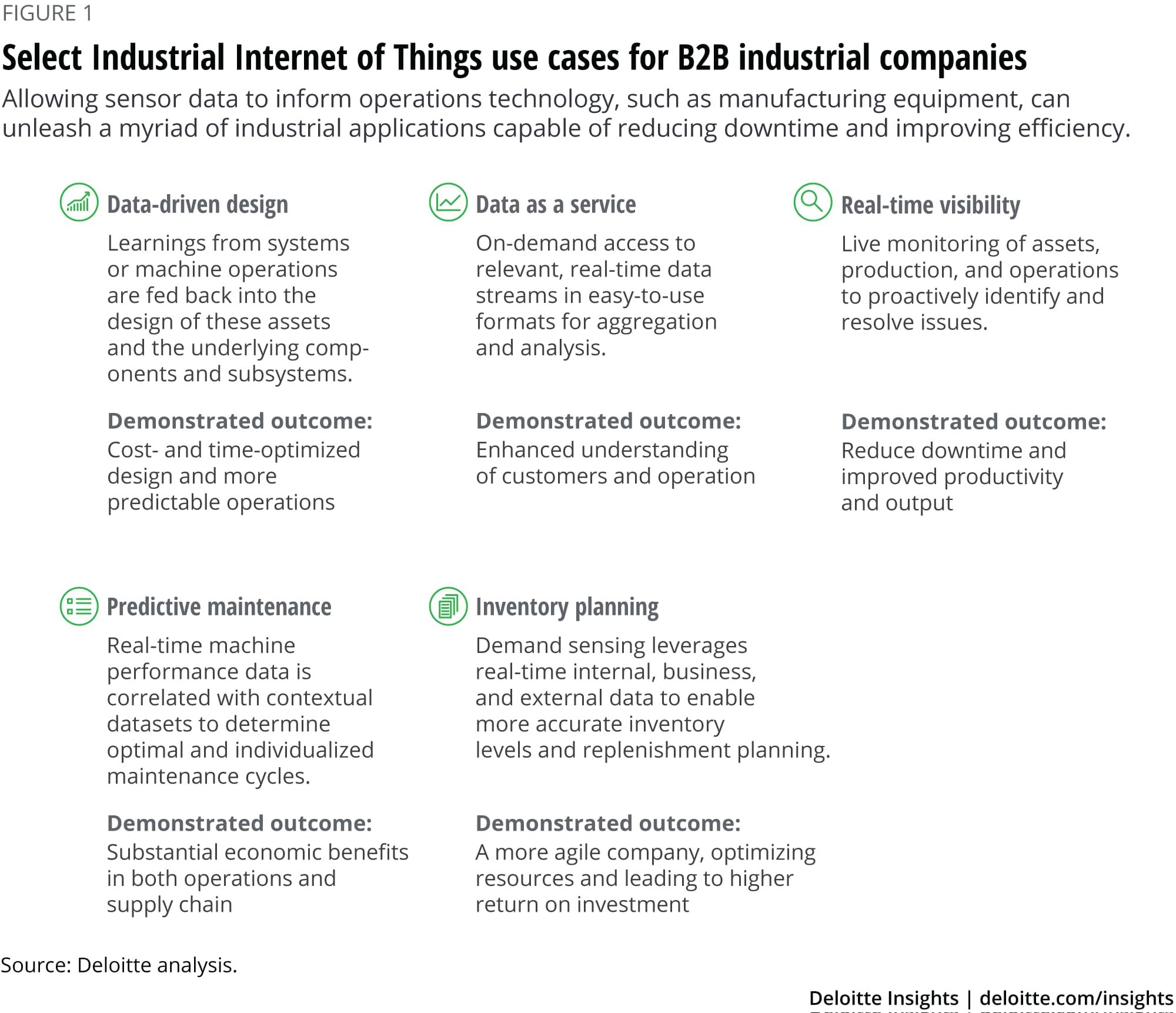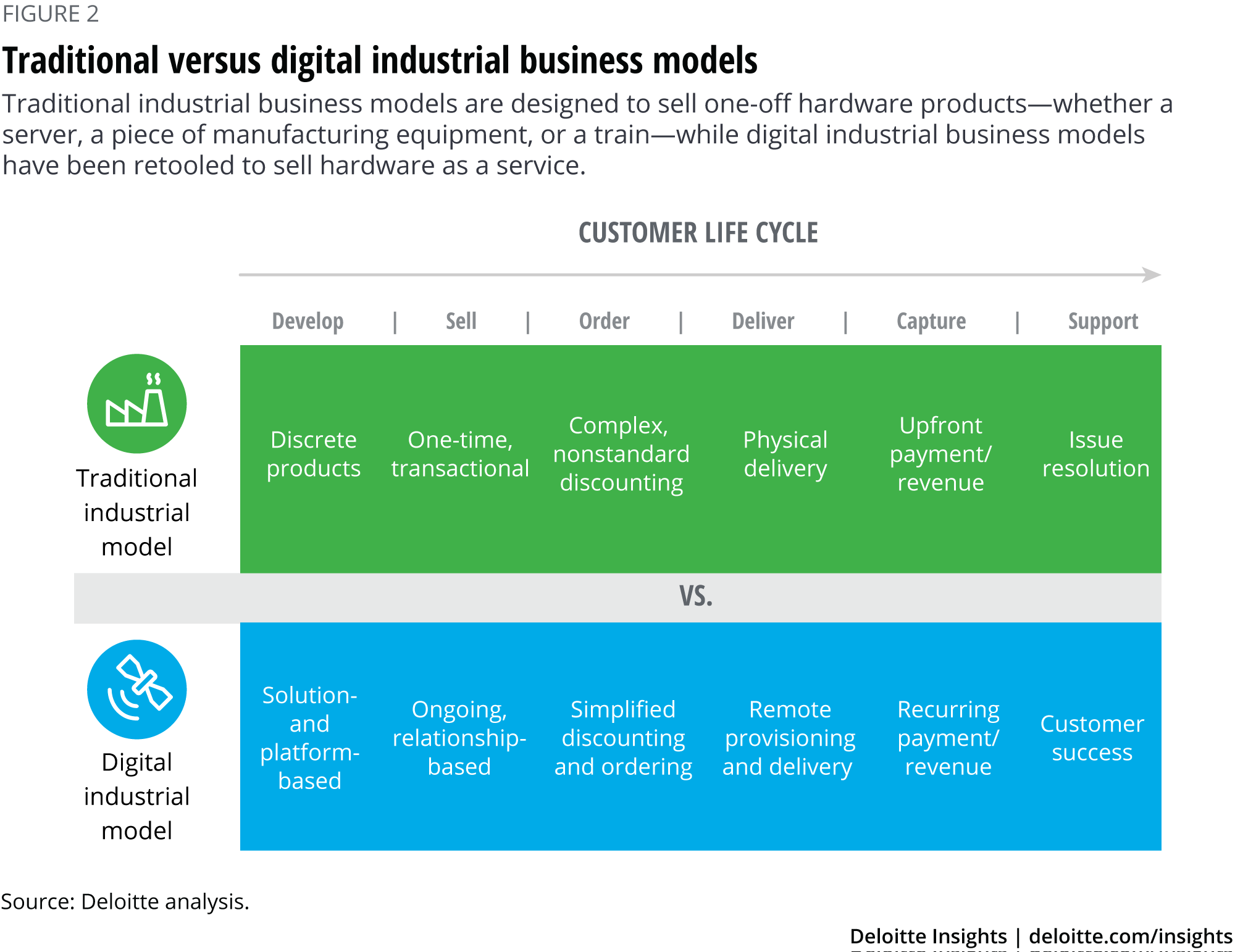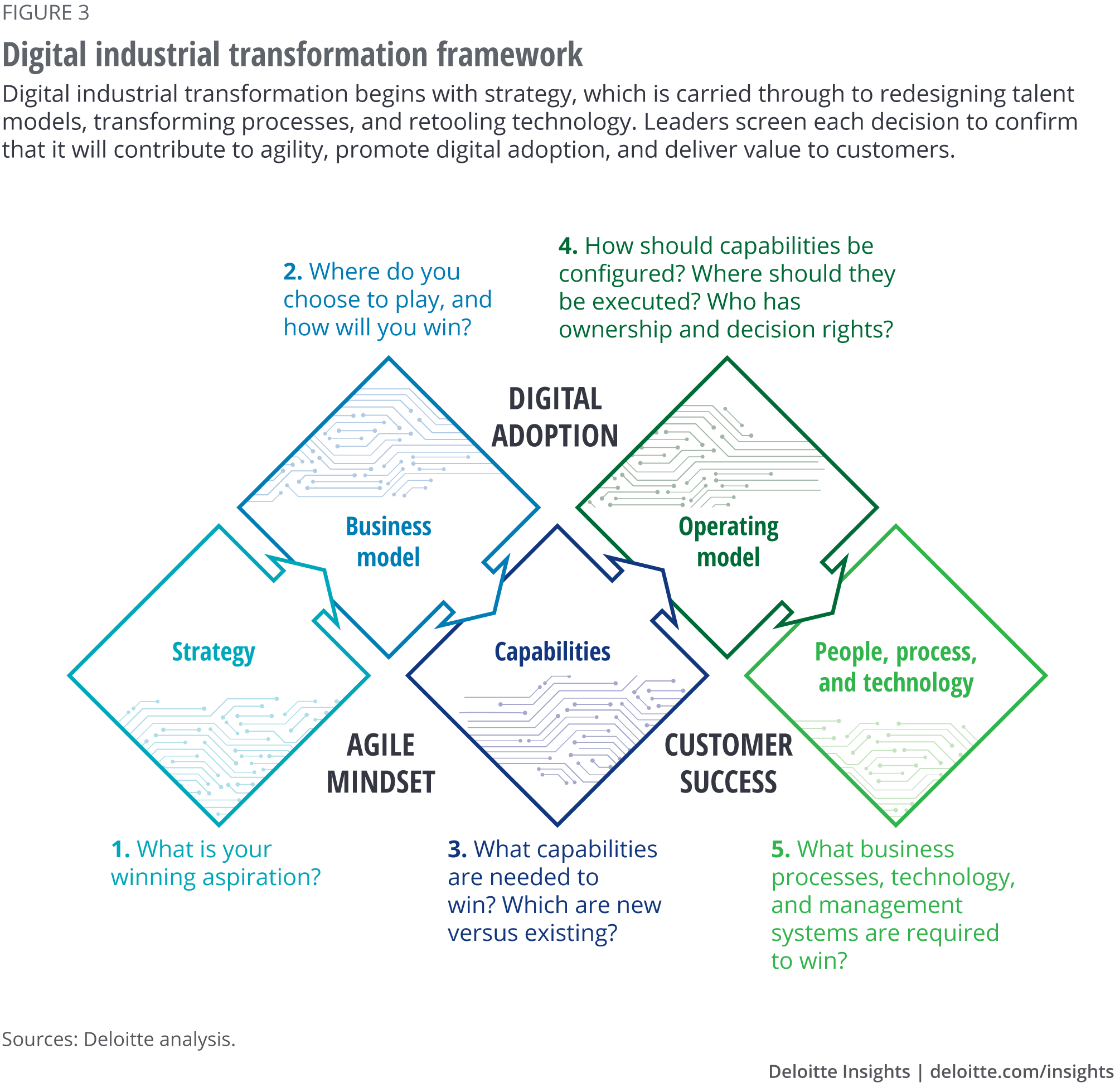
Digital industrial transformation Reinventing to win in Industry 4.0
6 minute read
17 June 2019
In a shifting market landscape with constant disruption, leveraging automation to optimize production is a challenge. Introducing a series of articles to help guide leaders through digital transformation in an Industry 4.0 age.
Introduction
Are you prepared to succeed in the Fourth Industrial Revolution? Accelerating consumer adoption of new technology and technological advances—in broadband networking, cloud-based computing and storage, sensor technology, and more1—are driving fundamental market shifts and a new wave of digital-driven disruption; value is migrating away from legacy products that are increasingly commoditized to the data that those products generate and the insights that data drives. In parallel, productivity has been plateauing in industrial production.2 To effectively optimize production through automation, leaders must look to leverage technology in new ways.
Learn more
Explore the Digital industrial transformation collection
Explore the Industry 4.0 collection
Explore the Internet of Things collection
Subscribe to receive more content from Deloitte Insights
As Internet of Things technology becomes ubiquitous, legacy B2B enterprises should rethink their products and services to thrive in an Industry 4.0 environment or risk being left behind by more nimble, digital-native competitors. This inflection point represents a real opportunity. Many leaders are aware of the need to adapt to the new paradigm of Industry 4.0 but unsure how to make it happen quickly. In a recent survey of 2,000 global C-suite leaders, the top three challenges for shifting strategy to meet the demands of Industry 4.0 were lack of vision, too many technology choices, and organizational or geographical silos.3
Over the coming months, in a series of articles, we will be walking through frameworks and approaches that can help you overcome these challenges. Through an effective digital industrial transformation, you can reinvent your business to win in Industry 4.0.
What is Industry 4.0?
The term Industry 4.0 encompasses a promise of a new industrial revolution, one that marries advanced manufacturing techniques with the Internet of Things to create manufacturing systems that are not only interconnected but communicate, analyze, and use information to drive further intelligent action back in the physical world.
Industry 4.0 and the Industrial Internet of Things
First, let’s talk about Industry 4.0, and the Industrial Internet of Things (IIoT) specifically, to set the stage for digital industrial transformation. As previous Deloitte publications have laid out, Industry 4.0 is transforming how organizations run by bringing real-time data and intelligence to operations.4 This paradigm shift is transferring value from the physical to the software and from the process or function to the data. For example, a smart thermostat costs dramatically more than a traditional thermostat—and demands far more setup—but offers real data-generated benefits to consumers, including reducing power consumption, improving comfort, and learning to anticipate owners’ preferences. Consumers are proving to be willing to pay for data-driven insights, and increasingly, so are businesses.
The Industry 4.0 shift has given rise to numerous IoT-based applications in the industrial space (see figure 1). From inventory planning to predictive maintenance, the IIoT can dramatically enhance operational and capital efficiencies across entire ecosystems.

What is digital industrial transformation?
To capitalize on this shift to Industry 4.0 and effectively create and monetize IIoT solutions, enterprises must embed new digital technologies and capabilities in their legacy assets. We refer to this as digital industrial transformation.
As with most fundamental shifts, this change is easier to execute in theory than in practice. Standing up a digital industrial operation involves fundamental shifts across all aspects of business. Specifically, to create value throughout the customer life cycle, an organization must reorient its business model from linear to always-on. For example, customer service in traditional business models begins once a customer reaches out with an issue for resolution; in digital industrial models, services teams may remotely track usage and performance, predicting when there might be an issue and proactively reaching out to the customer to resolve it, reducing downtime (see figure 2).

This demands a major shift in mindset as well as processes, and the challenge gets more complex when companies try to balance their legacy businesses with emerging offerings and newer business models.
This realization may be the reason why, in recent Deloitte global surveys, 94 percent of executives in industrial companies see digital transformation as a top strategic priority5—but only 14 percent are highly confident that their organizations are ready to fully harness the changes associated with IIoT/Industry 4.0.6
Embarking on the digital industrial transformation journey
Deloitte has collaborated with several high-tech and industrial companies to help drive their digital industrial transformation agendas. Most have focused on retooling their own operations, introducing advanced analytics into products. For example, one rail freight operator implemented IoT telematics solutions to develop an in-vehicle monitoring system, spanning more than 1,500 vehicles scattered across 30 locations. From analyzing the data gathered through this monitoring system, the company was able to realize over 10 percent reduction in fleet costs through fuel economy, idling reduction, and improved purchase habits. Furthermore, its safety incidents and breaches fell by over 90 percent.7
However, some industrial manufacturing leaders see bigger market opportunities and have taken more ambitious perspectives, looking to pivot their business model to help others adapt to Industry 4.0 and expand their own product portfolio to offer IIoT solutions. For example, Hitachi Vantara embarked on a multiyear transformation from a hardware-focused business to an as-a-service business, enabling enterprises to embed IIoT in their existing operations.8
Whether retooling internal operations or transforming your business to play in the IIoT market, effective shifts to digital industrial business models should be grounded in five guiding questions (see figure 3).9

Together, the answers to these questions help guide the direction of the transformation and align leaders to a shared vision for the future. All are needed to bring digital industrial transformation to fruition.
Digital industrial transformation in action: Hitachi Vantara
In early 2017, Hitachi Vantara—then known as Hitachi Data Systems, a US$4 billion, California-based subsidiary of Hitachi Ltd.—saw startups beginning to overwhelm traditional data storage market leaders. These software-oriented companies were finding new ways to gather, analyze, and apply customer and operations data—data that Hitachi Vantara had helped its clients manage and protect for decades. Hitachi executives concluded it was time to act.
Combining the data center infrastructure of Hitachi Data Systems, the data software expertise of Hitachi Insight Group, and analytics from its Pentaho division, Hitachi Vantara made its official debut in September 2017. Leaders defined a clear strategy and business model, aiming to help customers collect and manage information—and then turn that data into meaningful insights, using a combination of operational and information technology expertise. Within these guardrails, leaders then embarked on rethinking the enterprise operating model, focused on redefining the capabilities that sales, services, and product needed in order to transition from a hardware-oriented business to a software and services-focused model. In parallel, they began to reimagine what was key to differentiation and realized that technical prowess was not enough to win in Industry 4.0.
Ultimately, they shifted emphasis from standalone products to customer experience, customer success, and vertical-specific solutions. Hitachi Vantara also retooled underlying business processes—ranging from pricing and billing to demand planning and product development—in order to enable the new model and fuel the transformation. Last, leaders implemented a robust set of metrics with a rigorous approach to monitoring the success of the transformation.10
“Data is potentially a company’s biggest asset—if it can monetize it,” says Brian Householder, CEO of Hitachi Vantara. “Data holds the key to new revenue streams, better customer experiences, improved market insights, and lower costs of doing business. This new corporate structure and offering combine operational technology and information technology expertise to get at data’s true potential.”11 Within this new paradigm, Hitachi Vantara has already begun to see results, with its IoT solutions helping to increase one global manufacturer’s yield by over 90 percent.12
What’s coming next
Whether piloting IIoT in your own business or reinventing your entire business to help others adapt to Industry 4.0, it is critical to start with a clear strategy, set up the organization for success, and continuously monitor results to determine how best to correct course. Over the coming months, our series will touch on the most importance aspects of a digital industrial transformation, including:
Strategy. How do you create a vision for the future while balancing the needs of the legacy business?
Operating model. How should you rethink an enterprise’s operations to succeed in Industry 4.0?
Product. How can you accelerate new product development in emerging areas of technology?
Standing up digital capabilities without a corresponding realignment of strategy and operations may well lead to organizational confusion and lackluster results; executing both will help determine the winners in Industry 4.0.
Trending articles
-
Industry 4.0 Collection
-
When the Internet of Things meets the digital supply network Article5 years ago
-
Industry 4.0: At the intersection of readiness and responsibility Article4 years ago
-
The Industry 4.0 paradox Collection6 years ago
-
Building Industry 4.0 capabilities through collaborations and startups Article6 years ago
-
Internet of Things Collection

















